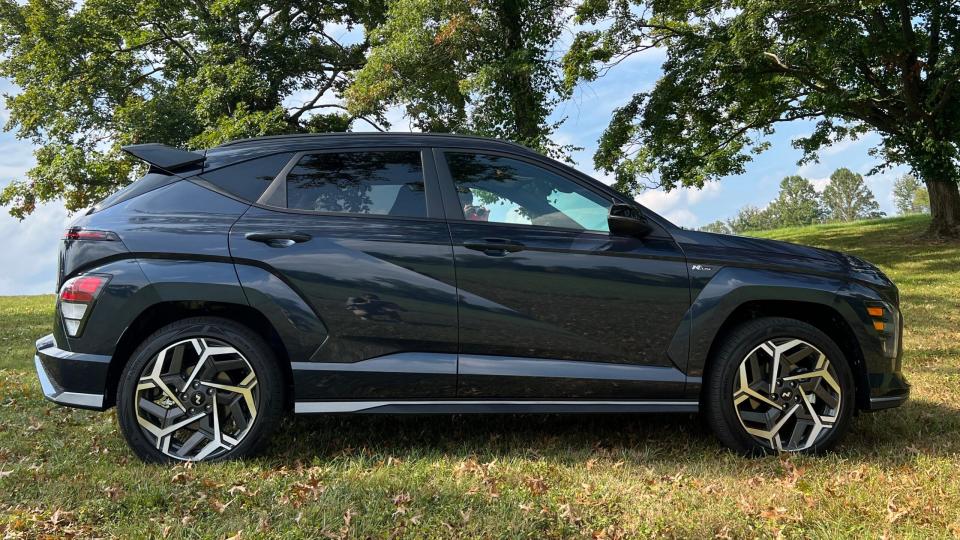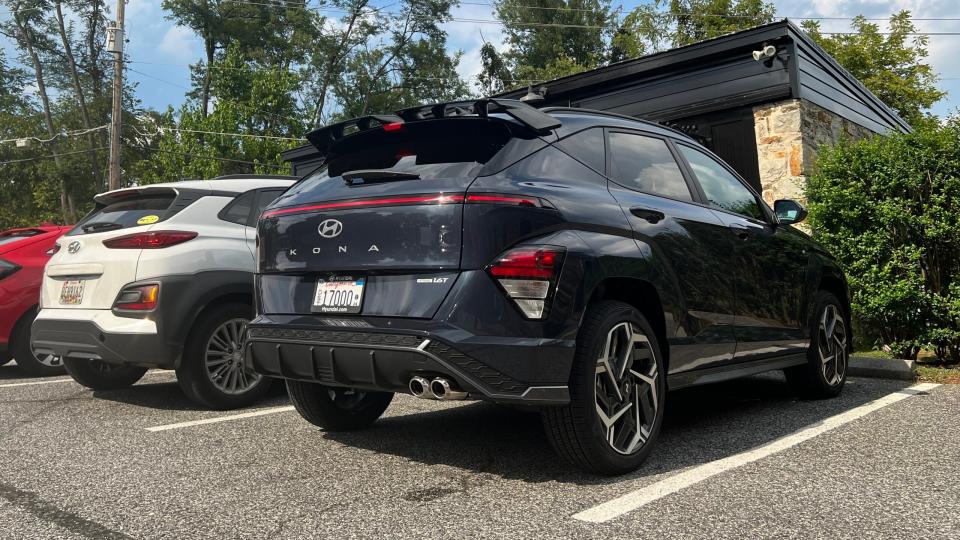2024 Hyundai Kona First Drive Review: All Grown Up

Growing up doesn’t have to be a bad thing. Sure, you have more responsibilities, but hopefully you learn some tricks to make life easier and have a few more dollars to spend on cool toys. With the 2024 Hyundai Kona, the crossover enters its second generation and grows up big time. No longer the brand’s entry-level SUV—the subcompact Venue bears that distinction—Hyundai’s designers took the opportunity to expand its footprint and get fancier.
Taking inspiration from its upmarket Ioniq EV models, the new Kona has matured into a handsome, sporty-looking compact SUV that packs significantly more room and utility into a package only slightly larger than the outgoing one.




SE AWD:
SEL FWD:
SEL AWD:FWD:
AWD:Quick Take:Score:
2024 Hyundai Kona Specs | SE/SEL | N Line/Limited |
|---|---|---|
The Basics
Hyundai has been killing it lately. Sales are up consistently year-over-year, and its SUV lineup has expanded from just two models—the Tucson and Santa Fe—in 2017, to seven today, which together make up 73% of the Korean automaker’s total volume. With an ambitious goal of 11 new EVs by 2030, Hyundai developed the new, second-generation Kona compact SUV as an EV platform first, reversing the normal ICE-to-EV development flow.
The Kona Electric was only available for a preliminary drive—more on that later—but the gas-powered Kona offers a choice of two carryover engines and four trim levels, with a single option package. The entry-level SE and SEL models use a 2.0-liter four-cylinder engine making 147 horsepower and 132 lb-ft of torque routed through a continuously variable automatic transmission for prices starting in the $20,000s. N Line and Limited models get the 1.6-liter turbocharged four-cylinder now making 190 hp and 195 lb-ft of torque and an eight-speed automatic transmission (goodbye DCT) in the low $30,000s. All-wheel drive is available for a $1,500 upcharge on all trim levels and can send up to 50% of the car’s available power to the rear axle in Sport mode. Notably, the Kona Electric is front-drive only.




Outside, the Kona grows 5.7 inches in length over the previous model, an inch in width, and 2.5 inches in height. That gain contributes to longer overhangs, as the wheelbase stretches just 2.3 inches. Its exterior design is somehow sharp and smooth, preserving the original Kona’s signature reverse-shark C-pillar and composite light design at the front and rear. I think it looks great, particularly in tennis ball (Neoteric) yellow and Mirage Green.
Inside, the gains in useful space are substantial: three more inches of rear legroom thanks in part to a thinner front seat design, another three inches of front headroom, over six cubic feet of extra rear cargo room with the rear seats up, and 17.9 more with them down. Speaking of the trunk, it has clever storage clips to secure the cargo cover vertically while you're not using it. It's a simple, clever solution that every hatchback and SUV should have.



Driving Experience
Stepping into the Kona, it’s immediately apparent that Hyundai was going for a classier vibe. In the Limited AWD trim, you’re greeted by a leather seat, Hyundai’s four-dot steering wheel, and a configurable center console with flip-out cupholders similar to those in the Palisade and Kia EV9. Selecting drive and getting going with Hyundai’s new shift-by-wire stalk takes a little practice but is reasonably intuitive. My only gripes are that the wireless charging pad’s enclosure is slightly small for a phone that’s plugged in—there's no wireless Apple CarPlay, weirdly enough, more on that later—and that even on the top trim, there are some cheap-feeling plastic bits on the door card armrests. The front passenger also gets a storage slot above the glove compartment, but it’s half an inch too narrow to accommodate a standard iPhone 13 in a case.

The Kona cruises quietly on the highway with the windows up, allowing for easy conversation. The 1.6-liter turbo-four’s broad torque curve provides plenty of punch for merging and passing, and the eight-speed automatic shifts smoothly, either using the steering wheel-mounted paddles or by kicking down on its own. I noticed a laggy throttle response in Normal mode, though, especially when accelerating from a roll. This lag proved annoying when accelerating out of turns, especially from red lights or stop signs onto main roads. I asked two Hyundai engineers about this and was told that the throttle response was calibrated for comfort and smoothness in Normal mode, and to try it in Sport. Sure enough, Sport solved the issue—but at the expense of artificially heavy steering and aggressive bright red gauges.

Handling is a similar story. The Kona’s chassis is balanced and its steering is accurate, making it easy to drive smoothly on a back road. But the suspension feels underdamped, moving around and taking a while to settle after highway expansion joints and back road crests and dips. I hoped the N Line car would be better but was told by the same engineer that it’s an appearance package that doesn’t touch suspension tuning. It’s clear Hyundai has the right ingredients here, both in the powertrain and the chassis, but the current calibration just feels slightly off.
Kona Electric Preview


I only got a 10-minute chaperoned drive in the Kona Electric, but it was very pleasant. After driving the Ioniq 6 at a Hyundai event last month, I was curious how the brand’s bullish EV strategy would translate into a cheaper package, and I wasn’t disappointed. Visually, it’s pretty much identical to the ICE Kona, save for a smoothed front end, unique wheels, and a visible charging door on the nose. The EV’s powertrain calibration is excellent, trading the outgoing generation’s tire-roasting torque for more usable thrust between 20 and 60 mph. I was skeptical of its 188 lb-ft torque figure (down from 291 lb-ft in the previous model), but a powertrain engineer explained that they focused on spreading out the useful power rather than maxing out a stat sheet. That’s reflective of Hyundai’s approach to EVs on the whole and is a welcome change in the industry.
Hyundai expects 200 miles of range out of a 48.6-kWh battery pack on the standard-range Kona Electric, and 261 miles from a 64.8-kWh pack on the long-range model. Level 2 charging times have dropped to just under five hours on the standard range and just over six on the long range. The Kona Electric is front-drive-only, I’m told, to keep range and price competitive. Hyundai hasn't announced final pricing, so stay tuned for a more in-depth drive.




Hyundai Kona Features, Options, and Competition
All 2024 Kona models come standard with a 12.3-inch touchscreen infotainment system plus plenty of tactile buttons for core functions like climate control on the center console and steering wheel. A Convenience package available on SEL trims includes ADAS tech including Highway Driving Assist, Frontal Crash Avoidance, and adaptive cruise control, as well as nav. Curiously, Konas with the navigation system loses wireless CarPlay and Android Auto in favor of a wired system—a head-scratching move Hyundai says it’s planning to fix in an over-the-air software update later this year.
The Kona competes with the Honda HR-V, Toyota Corolla Cross, Subaru Crosstrek, and Chevy Trax, among others. The HR-V and Corolla Cross are tried and true choices in the segment, while the Crosstrek and Trax are also rocking fresh redesigns for 2024. The Trax is cheaper—its most expensive trim starts at $24,995—and its new design is a win, but it's less powerful and less fancy inside. The Crosstrek trades on its symmetrical all-wheel drive and outdoorsy brand cachet, but its 2.0- and 2.5-liter engines have less usable torque than the Kona's. Only the Corolla Cross has more cargo space in the segment.




The Early Verdict
The second-generation Hyundai Kona has grown up in the right ways. It’s comfortable, intelligent, and easy to live with, all while improving the visual charm that set the first-gen car apart. It offers more style, tech, and interior room than most of its rivals while staying competitive on price and fuel economy.
It also brings Hyundai’s upscale design ethos into perhaps the cheapest car yet, making something once entry-level feel surprisingly expensive. It's a few finishing touches away from being a standout, but overall, Hyundai has the right recipe for a smash hit in the making.

Got a tip? Send us a note: tips@thedrive.com

 Yahoo Autos
Yahoo Autos 